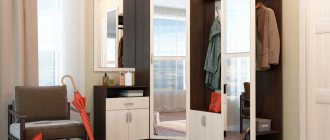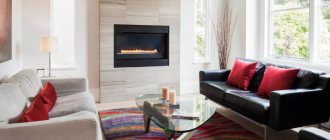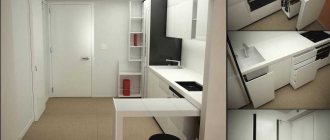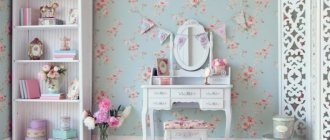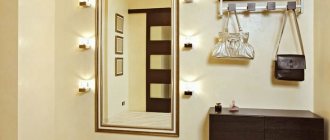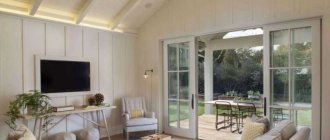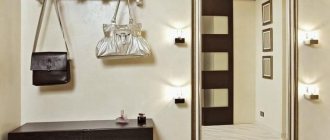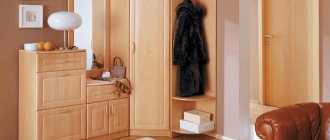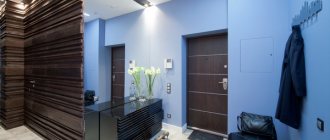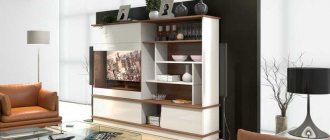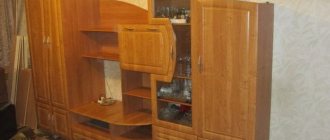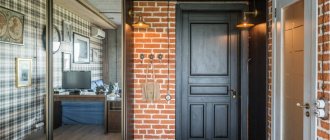Purpose of a mirror in the living room
By correctly positioning mirrors, you can not only expand the space and change the shape of the room, but also increase the intensity of lighting.
Another point - mirrors may be needed to emphasize the features of the style. They can be used both for their intended purpose and to highlight and enhance the beauty of unique objects.
- To ideally position mirrors in a room and avoid making fatal mistakes, it is better to seek help from an experienced designer.
- If this is not possible, you can choose the appropriate option by looking at photos on the Internet and product catalogs in stores.
- When imagining how the room will be transformed, you need to take into account the reflective properties of the mirror surface.
- Small living rooms make a much more pleasant impression if they have mirrors.
You can place several small mirrors on the wall, making a beautiful composition out of them. But at the same time, there should be no mirrors on the opposite wall.
In narrow rooms, mirrors are always attached to a wide wall so as not to create the effect of a long tunnel. In rooms with dark finishes, mirrors create a mysterious atmosphere and do not affect the visual volume of the room.
Types of mirrors
Our reflections accompany us everywhere: private apartments, offices or conference rooms - if the mirror is not on the wall, it means it is on the ceiling or somewhere else. It is difficult to name a room where a mirror would be inappropriate. Initially demonstrating the wealth of the owner of the house, in a modern interior mirrors make possible the visual transformation of space.
In the interior, stationary mirrors are used, fixed to the surface of the walls, ceiling or floor, and mobile mirrors - portable or mobile, for example, a tabletop mirror on a dressing table or a mobile mirror on casters in a dressing room or hallway. An intermediate position is occupied by mirrored doors or windows.
Mirrors are produced:
- Leafy. A sheet mirror has a square or rectangular shape; it is glass with a reflective layer applied to one of its surfaces.
The thicker the sheet, the better and more expensive the mirror. - In the form of a panel. Mirror panels do not have chamfered edges, and processing carried out using special technology gives them a decent appearance and maximum safety. Their sizes vary and range up to five square meters. Decorative bevels that complement some panels allow you to create an original relief pattern.
Mirror panels are made of acrylic and can create incredible visual effects that give the room a luxurious, sophisticated look. - In the form of tiles. Mirror tiles are fragments of an ordinary sheet mirror that have a special shape. The edges of the tiles are decorated with a chamfer, which is invisible to the eye, but thanks to it, the edges of the mirror are no longer sharp. Modern high-quality mirror tiles are manufactured strictly in accordance with GOST standards and their strength is in no way inferior to the strength of ceramic tiles
- In the form of a mosaic. Mirror mosaic is a modern decorative technology in which the ornament is laid out from small pieces of mirrors of a certain shape.
Mosaic transforms the interior, smoothes out its roughness and emphasizes its advantages
Sheet mirrors are cut into panels, glued to a base made of plastic or wood materials and used as ceiling or cladding panels fixed to a frame.
Mirror tiles and mosaics are cut from sheets 1 cm thick into rectangles, squares or triangles. The edges are polished, forming a bevel. As an optics instrument, mirrors are distinguished:
- flat;
- spherical, convex and concave; Spherical mirrors can reflect the entire room
- parabolic;
- hyperbolic;
- elliptical.
Mirrors with optical distortion are rarely used in interiors; they are produced mainly for industrial needs and used in devices. However, with the help of spherical mirrors you can illuminate a dark room, and by placing mirrors at an angle, you can create the illusion of infinite space.
Mirror surface colors:
- silver;
- gold;
- bronze;
- graphite.
Colored mirrors are used in interior design in modern styles
A mirror made of tinted glass or with a colored backing, matched to the color scheme of the interior, will add elegance to the front room or bring tranquility to the bedroom interior.
Shape of mirrors
The geometry of the mirror can be absolutely anything. The main forms are:
- rectangular; Long rectangular mirrors have a maximum reflection area and fit comfortably into the perimeter of a wall or cabinet door
- square;
Square is a laconic mirror shape that complements simple interiors well, but functionally a square is inferior to a rectangle - rhombic; Diamond-shaped mirrors add playfulness to the room
- trapezoidal; A trapezoidal mirror in the interior performs the same function as a rectangular one, but has a more non-trivial appearance.
- round; A round mirror can be hung in the center of a square or rectangular wall, where the perfect elliptical shape will visually soften the corners
- oval.
Convenient elongated shape without corners reflects a person to his full height without taking up extra space on the wall
Mirrors of non-standard shape are used in the interior when it is necessary to emphasize the originality and originality of the owner of the room or to dilute minimalist, laconic interiors. It is easy to create a composition on the wall from canvases of various shapes, and fantasy-shaped mirrors are art objects in themselves.
The fantasy shape of the mirrors corresponds only to the designer’s intention, it can be:
- a drop;
- Puzzle;
- butterfly;
- heart;
- geometric pattern;
- floral ornament;
- silhouettes.
Individual elements can be easily transformed into a picturesque picture that will become the dominant feature of the interior.
Photo gallery: fantasy-shaped mirrors
The frame of the mirrors should be combined with the design of the walls and the style of the interior
Decorative mirrors of original shape will become a real decoration of your interior.
If you want something new, you can experiment with hanging several designs of different sizes along all the walls of the bathroom.
It is worth placing a mirror next to light-loving plants, which will receive more light
Choose a mirror based on the general style of your room, as well as the individual needs of the apartment’s residents. Properly selected mirror surfaces will help illuminate dark areas, show luxury and expand the space in the room
Never buy a mirror under artificial light; if you can’t come to the store during the daytime, it’s better to postpone the purchase until later
If your room is small and its windows face north, choose large mirrors
Types of mirror processing
Mirror surfaces can be subjected to various treatments:
- Standard processing - we have a simple mirror, without design frills.
- Sandblasting. A pattern is applied to the surface of the mirror by damaging its surface with sand or other abrasive powder sprayed by a stream of air.
A matte pattern will help you to easily solve the problem of turning an ordinary object into a unique decorative element. - Artificial aging. Today, aged mirrors are gaining more and more popularity. In real life, mirrors age for a very long time, so masters have learned to age mirrors artificially. Since such mirrors acquire a patina and cannot fully fulfill their main function - to reflect reality, they are more often used as a decorative element.
An aged mirror brings the spirit of romantic antiquity to the interior of the room, perfectly emphasizing the festive and solemn atmosphere - Fusing. This is a new technique for making stained glass, which involves heat treating pieces of glass in a special print. Using this technique, a certain pattern is applied to the mirror. An ordinary wall mirror, without representing any aesthetic value, decorated with fusing, instantly becomes a masterpiece, like a beautiful painting
- Stained glass painting. You can paint the mirror yourself or make a drawing to order.
With certain skills, stained glass painting can be done independently
Any mirror made to match the interior according to the designer’s original plan becomes a designer mirror. What the mirror will be like: shape, color, execution technique is chosen by the author of the project. The options are endless. For the interior, you can order a designer mirror separately, as a work of art.
A mirror can combine several types of processing, for example, a sandblasted pattern can be additionally decorated with stained glass painting
A special type of mirror is worth special consideration: fireproof and moisture resistant. The basis for the fireproof mirror is suitably tempered glass. With a thickness greater than ordinary sheet metal, fireproof can withstand high temperatures and is used to make partitions along escape routes in offices and industrial facilities. Since standards in private housing construction do not require fire-resistant partitions, such mirrors are used extremely rarely in residential premises. And the price of such mirrors is quite high.
A kitchen apron can be made from a fire-resistant mirror
Moisture-resistant mirrors, on the contrary, are in high demand. They are used in the production of mirror tiles and mosaics for rooms with damp and wet conditions - bathrooms, baths, saunas, swimming pools. Moisture-resistant mirrors differ from ordinary mirrors in the presence of a protective moisture-resistant coating on the amalgam - film or varnish.
The moisture-resistant surface is made using different materials than conventional reflective surfaces
Mirror furniture
Furniture using mirrors is appropriate in any room. Thanks to mirrored furniture facades, you can visually enlarge small rooms. Mirrored furniture is produced for bathrooms; sliding wardrobes with mirrored fronts are popular for bedrooms and hallways. In addition to the effect of expanding space, they serve a utilitarian function and disguise storage systems.
Thanks to its original appearance, mirrored furniture will make the interior truly luxurious and will look sophisticated, rich and elegant.
Using a film with a mirror effect, it is easy to decorate old furniture, turning a closet, chest of drawers or coffee table into an art object.
Restoring furniture with your own hands will allow you to make new furniture from old furniture - stylish and unique.
Mirror compositions
One of the techniques for decorating rooms is creating compositions from mirrors of different sizes and shapes, decorated in interesting frames. This technique will bring light into the room and add originality. Mirror compositions decorate the walls of living rooms, bedrooms, halls and staircases.
For a mirror composition, mirrors similar in style are used
Decorating the living room with mirrors
Mirrors change the appearance of any living room, sometimes beyond recognition. When designing, it is necessary to take into account that products are chosen taking into account the characteristics of a particular style. For example, for a classic living room, mirrors are selected in frames covered with gold or made of wood.
Mirrors without frames are suitable for a living room in a minimalist style, and options with an unusual shape fit perfectly into the Art Nouveau style.
Functional round mirrors
Timewatch elegantly combines a mirror and a round watch. Scandinavian design is all about modesty and simplicity, which also shows in the choice of materials. A clock without a dial creates a minimalistic look and allows you to place the model in different positions on the wall:
In the photo: mirror with Woud Timewatch . Ideal for hallway design.
Verde Mirror is a functional design with smooth curves and clean lines, inspired by the metal furniture of the 1950s. The mirror is surprisingly versatile, designed for various spaces. Hidden behind the mirror is a small shelf with slots for hangers. Use a hoop to hang clothes, scarves or towels:
In the photo: the Woud Verde is equipped with a towel handle, which is made of painted metal.
The Pocket Mirror is a minimalistic and functional design designed for storing small items. The wooden “pocket” is made of oak and is suitable for everyday small items. Smooth and soft shapes create a harmonious atmosphere:
In the photo: mirrors with Woud Pocket .
The steel frame design houses four perforated storage drawers, a black marble plate and a mirror. The drawers and marble slab can be arranged as desired and used for a variety of purposes, making the Woud Mirror Box ideal for a hallway, bedroom or office:
Pictured: Woud Mirror Box . Use it to store cosmetics, jewelry or office supplies. Thanks to its graphic expression and minimalist design, the Mirror Box will be a wonderful decoration for any wall.
In the photo: Tonin Casa Sunset with a wooden shelf in canaletto walnut or dark oak.
Location options
Mirrors in the living room were usually always located above the fireplace. This design became popular back in the Middle Ages. Then, candelabra were placed on both sides of the mirror, which provided good lighting.
- Today, such design can only be considered a tribute to tradition. In modern candle fireplaces, mirrors can even be located inside.
- Another popular place to place a mirror is the wall above the sofa. If the area of the room allows, you can make the wall behind the sofa and armchairs completely mirrored.
Mirror placement
Proper placement is perhaps the most important part. After all, a successfully installed mirror critically affects the entire appearance of the room.
A mirror in a dark corner will visually make the room narrow, and in a light corner it will do exactly the opposite.
Here is a small list of the most successful and common places.
Classic installation locations
Mirror above the sofa in the living room. Perhaps the most famous way. While relaxing on the sofa, the mirror will not catch your eye and irritate you.
Above the fireplace. Usually this space is always empty, and a mirror will help fill the void.
On the wall adjacent to the window. Allows you to illuminate the room.
Between two windows.
Unusual installation locations
If you want to stand out with your unusual taste, then there are many unusual places to install mirrors. Here is a small selection of the most famous.
Creating mirror compositions
Compositions made up of several mirrors look very impressive in a modern interior. You can also use mirror tiles or mosaics.
Designers suggest placing such a composition in any place you like. Most often it is placed in the center of the wall above the sofa or fireplace.
To create an interesting composition, it is better to choose mirrors of the same shape, but of different sizes. Ideally, each of them will be placed in the same frames. Then all the elements are assembled into a single composition and inserted into a common frame.
Mirror walls in the interior. Details and facts
A mirror wall is a vertical surface, the area of which is finished with a material that reflects light. In one case, mirrors cover the entire wall with a whole material, in another - these can be elements that exist separately from each other. To fasten mirrors, glue, clamps or a frame are used.
What is a wall of mirrors in the interior of a room? This:
- an ensemble of mirrors that can be either framed or without it;
- a wall with mirror tiles, panels or wallpaper;
- wardrobes with doors entirely covered with mirrors;
- various furniture that includes mirror material in its design.
To decorate rooms, mirrors that are not quite familiar to the average person are used. Their surface is not always smooth or clean; there are corrugated surfaces or with a sandblasted pattern. Lovers of retro and vintage will like “vintage” mirrors (with an aged effect), and those who prefer high-tech and laconicism will like frameless mirrors that make the surface uniform.
Related article: What are embossed vinyl wallpaper on a non-woven backing
Modern designer stores offer customers not only standard glass mirrors, but also acrylic, a flexible material.
Using mirror panels
In modern rooms, one of the walls of the living room is often decorated with mirrors, creating some kind of original pattern. Let's say you can place narrow mirrors at the same distance so that they line up in one vertical line from floor to ceiling.
This is a very effective technique that designers often use to increase the height of walls.
Furniture with mirrors
According to popular opinion, furniture with built-in mirrors can only be placed in the hallway or bedroom. However, the area of a small apartment often does not allow this.
A large and spacious wardrobe thus appears in the living room. The doors can be decorated with mirrors, which allows you to visually enlarge the space.
Even if such a cabinet has large dimensions, due to the mirror coating it will not weigh down the interior. This is an excellent solution for owners of not too spacious city apartments.
How to install mirrors yourself?
If you are a jack of all trades, then you can carry out the installation and design yourself, you just need to adhere to the main points:
- The wall needs to be assembled from separate pieces, for example tiles, but in this case it is necessary to decide what will be between them.
- Large monolithic mirrors are best installed with the help of craftsmen.
- If the mirror is cracked or broken, it is best to buy a new one. Not because of superstitions, but because decorating a room with a broken mirror is ugly and dangerous.
Current models
Mirror fashion changes every year. For example, large floor models are now favorites among designers.
They are recommended to be purchased for decorating any interior: They look respectable and expensive, allowing you to create a feeling of comfort and luxury.
- Another new trend is creating interesting designs on a mirror surface. These can be plants, flowers, landscapes, city panoramas.
- If you organize such a mirror with spectacular lighting using LED lamps, you can create the impression of an object floating in the air.
- Original models and broken mirrors are popular. Boiserie panels look interesting in the interior of the living room. Mirrors are inserted into them, just like in the original frames.
The role and significance of mirrors in the bathroom, kitchen, hallway, living room and bedroom
Mirror walls in the bathroom interior
Mirrored walls seem to be made for spacious, well-lit bathrooms, so you should plan the placement of lamps in advance. Instead of the usual mirror from the bathroom set above the sink, you can make a composition of mirror tiles. A wall completely covered with mirrors in front of a cubicle or bathroom is a good find, but in front of the toilet - no, no, and no again. And of course, you should take good care of the cleanliness and shine of mirrors, wipe them from drips and drops; this is not difficult to do, fortunately, there is now a huge selection of products for mirrors and glass.
Mirror walls in the kitchen interior
Mirrored walls are suitable for modern, newfangled kitchens that combine laconicism, the cool shine of chrome parts, a lot of light and air. They are perfect for decorating a dining room, the only thing is that mirror blocks need to be placed at the top of the wall, where they will not reflect, and therefore irritate people. And, as mentioned above, the mirror can be hung so that it reflects the window, this trick will add light.
Related article: Installing a canopy over a loggia and balcony
Mirror walls in the hallway interior
In hallways with a mirror design, you should be careful and avoid mirrors opposite each other to avoid creating an unnerving mirror maze. It is advisable to dilute the interior of the hallway with a few mirrored details, no more, and to brighten it, hang lamps near the mirrors. For those who have a huge, spacious hallway, you don’t have to think twice about decorating the wall from top to bottom with mirror finishing. A sliding wardrobe will also fit perfectly in the hallway. A mirrored ceiling will appeal to originals and aesthetes; it will increase the space and increase the amount of light from lamps, which is extremely important in such a room. + tips for choosing a regular mirror for the hallway.
Mirror walls in the living room interior
This room is intended for relaxation and receiving guests, which means the interior design in it should be light, bright, and fresh. Here you can let your imagination run wild. Whether it will be a whole mirror wall or fragments, ornaments, mosaics - everything is appropriate. Mirrors in rich baguettes or frames with beautiful patterns are a great idea. Reflective finishes can be used on cabinet sides or coffee table surfaces, doors and cabinets.
Mirror walls in the bedroom interior
A mirrored wall will add luxury, elegance, and a touch of chic and aristocracy to this room. Due to the reflective elements, the bedroom will acquire a more mysterious and intimate atmosphere. Playing with lighting and illumination, coupled with mirrors, will allow you to give unexpected angles to the refraction of the beam. Most often, mirrors are placed on the ceiling or above the bed. Also, a mirror is an excellent solution for a dressing table or dressing table. More ideas for a mirror in the bedroom.
Recommendations for design
When decorating a living room with mirrors, it is worth considering a number of important points. For example, a mirror that is hung crookedly will instantly spoil the impression, even if it looks luxurious and is very expensive.
- In addition, in this case, the object’s center of gravity will shift, which can lead to it falling off the wall. Therefore, mirrors must be positioned perfectly evenly in space.
- Mirrors that are positioned incorrectly relative to each other can create psychological discomfort.
- Of course, you should not pay attention to existing superstitions. The fact is that mirror surfaces that reflect each other can distort the perception of space, resulting in a feeling of discomfort.
According to feng shui fans, mirrors have the ability to absorb energy. Therefore, it is recommended to position them so that they reflect details that carry a positive charge.
For example, flowers, landscapes outside the window, beautiful objects. Designers do not recommend placing mirrors opposite entrance doors, staircases and toilet rooms.
The correct placement of mirrors allows you to harmonize the space, and models in a suitable frame help to emphasize the chosen style.
Functions of mirrors in the interior
Before choosing mirrors for the living room, you need to carefully consider the room, figuring out where installation can be done and where not. Don't forget about the functionality of mirrors. Proper placement of mirrors can give effects such as:
- Expanding free space. Often used for small apartments.
- Improved lighting. The mirror can be positioned to reflect light objects, such as lighting fixtures or windows.
- Visual increase in wealth. By placing a mirror opposite any decorative items, you can visually increase their number.
- Changing proportions.
- Focusing attention. Installing a mirror opposite an important object in the interior will help concentrate attention on it.
But there are certain installation rules that should not be neglected:
- Mirrors should not be allowed to reflect on each other; constant contemplation of an endless labyrinth can have a harmful effect on mental health.
- Mirrors in dark rooms make the room smaller; it is best to install them in light rooms.
- You should not allow more than two large objects to be reflected in the mirror. A large number of items will look sloppy.
- According to the recommendations of psychologists, you should not install mirrors in visible places. Staring at your reflection for a long time can make people nervous.
- If the mirror is used for decorative purposes, then it must be installed at least one and a half meters from the floor.
